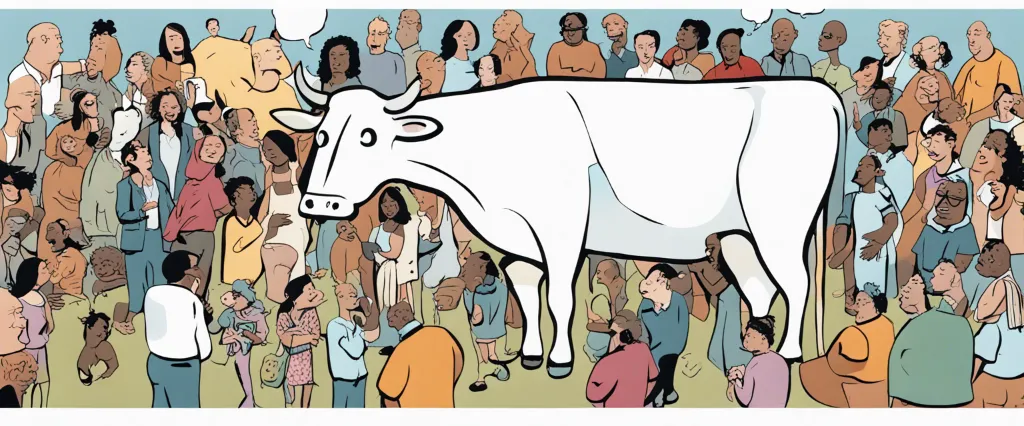
In the realm of modern business literature, it is not uncommon to come across a multitude of publications promising to unravel the secrets of success, leadership, and innovation. Among these countless works, two prominent books, namely, “The Big Moo” by The Group of 33 and “Socialnomics” by Erik Qualman, stand out as insightful guides for navigating the dynamic world of business in the 21st century.
“The Big Moo” by The Group of 33 is an unconventional yet thought-provoking collection of essays authored by an assembly of influential thinkers, entrepreneurs, and industry leaders. With a unique perspective, this book aims to challenge prevailing notions and encourage readers to embrace their own uniqueness as a means of sparking creativity and driving innovation. The diverse range of contributors lends a wide array of experiences and expertise, providing readers with a comprehensive understanding of the ever-evolving business landscape.
On the other hand, “Socialnomics” authored by Erik Qualman delivers an in-depth exploration of the impact of social media and digital technologies on businesses, industries, and societies as a whole. Drawing on extensive research and case studies, this book elucidates the powerful influence of social media platforms, demonstrating how they can shape consumer behavior, disrupt traditional marketing strategies, and transform the dynamics of business operations. Through an engaging narrative and compelling examples, Qualman offers valuable insights on how organizations can adapt to and leverage the social media revolution to stay competitive in an increasingly interconnected world.
While both books emphasize the importance of adaptability and embracing change, they approach the subject matter from distinct angles. “The Big Moo” advocates the significance of individuality and challenging the status quo, while “Socialnomics” delves into the realm of digital transformation and the pivotal role of social media. Despite their differences, these two books share a common goal of empowering readers to navigate the rapidly evolving business landscape and succeed in an era defined by constant disruption and innovation.
Embarking on a comparative study of “The Big Moo” and “Socialnomics” will shed light on their respective strengths, weaknesses, and core philosophies. By exploring the intricacies of these works side by side, we aim to unravel the diverse wisdom they offer, analyzing their applicability in various business contexts, and discovering the universal principles that drive success in the ever-changing world of commerce. Through this study, readers can gain a deeper understanding of how creativity, adaptability, and digital fluency intertwine to shape the modern business landscape, ultimately providing valuable insights into the art and science of succeeding in today’s fast-paced, interconnected world.
Brief Summary of Two Books
The Big Moo by The Group of 33
“The Big Moo: Stop Trying to Be Perfect and Start Being Remarkable” is a collaborative book written by The Group of 33, which includes business gurus, entrepreneurs, and renowned thinkers. It explores the concept of being remarkable in business and encourages readers to embrace their unique qualities rather than striving for perfection.
The book begins by challenging traditional beliefs and suggesting that the modern world is oversaturated with options, making it crucial for individuals and businesses to stand out. It argues that being good or even excellent is no longer enough; one must strive to be remarkable to succeed in today’s competitive market.
Throughout the book, The Group of 33 shares a collection of insightful stories, experiences, and advice to encourage readers to step out of their comfort zones and embrace their individuality. They emphasize the importance of taking risks, being authentic, and daring to be different. The authors assert that remarkable individuals and companies are driven by passion, creativity, and a willingness to challenge the status quo.
The Big Moo highlights the power of collaboration and community, underscoring the idea that remarkable achievements are rarely accomplished alone. It emphasizes the importance of building strong networks, fostering meaningful relationships, and leveraging collective wisdom.
Ultimately, The Group of 33 imparts the message that being remarkable is not about trying to please everyone or achieving perfection; it is about acting boldly, embracing vulnerability, and making a genuine impact. The book offers practical insights and strategies for individuals and businesses looking to move beyond mediocrity and thrive in a world that demands constant innovation and distinction.
Socialnomics by Erik Qualman
“Socialnomics: How Social Media Transforms the Way We Live and Do Business” by Erik Qualman explores the impact of social media on our society and businesses. The book emphasizes that social media is not just a passing trend but a crucial component of our lives that has transformed various aspects of communication, marketing, and consumer behavior.
Qualman highlights that social media platforms have empowered individuals by giving them a voice and the ability to connect and share information globally. The book explains how social media has changed the way we interact, communicate, and stay informed in both personal and professional relationships.
Furthermore, Qualman delves into the ways social media has disrupted traditional marketing and advertising methods. He discusses how businesses can effectively leverage social media to engage with customers, build strong online communities, and ultimately increase their brand presence and profitability. The book offers insights and strategies on how to effectively utilize social media platforms to listen to consumers, respond to their needs, and build long-term relationships with them.
Throughout “Socialnomics,” Qualman also explores the impact of social media on various industries such as retail, healthcare, education, and government. He analyzes real-life examples of organizations that have successfully incorporated social media into their strategies, as well as those that have failed to adapt adequately.
In conclusion, “Socialnomics” sheds light on the pervasive influence of social media on our society and the business world. It offers valuable insights and practical advice for individuals and organizations looking to navigate the rapidly evolving landscape of social media and maximize its potential for personal and professional growth.
Comparison between Two Books

Similarities in Business Strategy
“The Big Moo” by The Group of 33 and “Socialnomics” by Erik Qualman are two influential books that shed light on various aspects of the business world. While each book covers a wide range of topics, including marketing, leadership, and innovation, it is in the realm of business strategy that we find some striking similarities. This comparative analysis aims to explore and highlight the key resemblances in the approaches to business strategy presented by these two books.
1. Emphasizing the Importance of Adaptability:
Both “The Big Moo” and “Socialnomics” stress the significance of adaptability in today’s rapidly changing business landscape. They argue that businesses need to be flexible enough to embrace and leverage emerging trends and technologies. “The Big Moo” emphasizes that successful companies recognize the need for constant reinvention and encourage employees to think outside the box. Similarly, “Socialnomics” highlights the essentiality of adapting to the evolving digital world.
2. Creating a Customer-Centric Approach:
Both books underscore the importance of putting customers at the heart of business strategy. “The Big Moo” emphasizes the need to understand and connect with target audiences on a deep emotional level, fostering strong bonds that transcend mere transactions. “Socialnomics” expands on this idea by emphasizing the significance of social media platforms and their role in building and maintaining meaningful customer relationships.
3. Encouraging a Culture of Innovation:
“The Big Moo” and “Socialnomics” advocate for a culture of innovation within organizations. Both books argue that businesses must step outside their comfort zones, embrace change, and consistently seek new ideas and opportunities to stay ahead. They assert that innovation is not limited to product development but also extends to processes, customer experiences, and business models.
4. Harnessing the Power of Data:
Data-driven decision-making is a common theme in both “The Big Moo” and “Socialnomics.” They assert that businesses should harness data and analytics to gain insights into customer behavior, market trends, and strategic opportunities. “The Big Moo” encourages the use of data to make informed decisions and develop targeted marketing campaigns. Similarly, “Socialnomics” emphasizes the value of data in understanding market dynamics and developing personalized marketing strategies.
Conclusion:
“The Big Moo” and “Socialnomics” converge on several critical aspects of business strategy, highlighting the importance of adaptability, customer-centric approaches, a culture of innovation, and data-driven decision-making. These books provide valuable insights into contemporary business challenges and offer practical strategies to navigate the ever-changing business landscape. By drawing parallels between them, readers can gain a holistic perspective and apply these shared principles to their own organizations.
Divergences in Business Strategy
The Big Moo by The Group of 33 and Socialnomics by Erik Qualman are both influential business books that explore different aspects of business strategy. While they converge on certain ideas, there are distinct divergences when it comes to their approaches.
1. The Big Moo:
The Big Moo, written by The Group of 33, is a collection of essays by various authors that focuses on the concept of standing out and being remarkable in the business world. It encourages individuals to embrace their uniqueness and create a competitive advantage by challenging conventional thinking. The book emphasizes the importance of personal branding, creative thinking, and innovative ideas in developing successful business strategies. It aims to inspire readers to take bold actions and think beyond traditional boundaries in order to thrive in a rapidly changing business environment.
2. Socialnomics:
Socialnomics, authored by Erik Qualman, primarily revolves around the impact of social media on business strategies. It discusses how businesses can adapt and harness the power of social media platforms to drive growth, engage customers, and build brand equity. Qualman explores the influence of social media trends and highlights various success stories that have emerged through effective social media utilization. The book delves into the importance of digital marketing, social media analytics, and customer engagement strategies, with a focus on leveraging the potential offered by online platforms.
Divergence in Business Strategy:
While both books provide valuable insights into business strategy, they diverge in terms of their primary focus. The Big Moo emphasizes the need for individuality, collective creativity, and thinking outside the box. It encourages readers to develop unique business strategies that make them stand out from the competition. On the other hand, Socialnomics concentrates on the power of social media and the importance of integrating digital marketing strategies into the overall business framework. It urges businesses to embrace social media platforms and understand their impact on customer behavior and brand perception.
In terms of divergence, The Big Moo explores a broader range of unconventional strategies beyond just social media. It encourages individuals and businesses to tap into their creativity and discover innovative avenues that can differentiate them in the market. In contrast, Socialnomics concentrates its entire focus on the role of social media, providing specific tactics and case studies related to this domain.
In conclusion, while both The Big Moo and Socialnomics highlight different aspects of business strategy, their main divergence lies in the areas they emphasize. The Big Moo focuses on individuality, creative thinking, and challenging norms, while Socialnomics concentrates on the power of social media in driving business success. Both books offer valuable insights that can contribute to a well-rounded understanding of business strategy in a rapidly evolving technological landscape.

Conclusion
“The Big Moo” is a book written by The Group of 33, which consists of various well-known authors and business leaders. This book focuses on the concept of Remarkability – how to stand out and make a difference in a crowded marketplace. It contains a collection of short essays, each providing insights and ideas to help individuals and businesses succeed.
On the other hand, “Socialnomics” is a book by Erik Qualman, an author and public speaker renowned for his expertise in social media and digital marketing. The book explores how social media has transformed traditional marketing and offers insights into leveraging this shift to drive business growth and success.
To determine which book is more worthy of reading, consider your interests, professional goals, and any specific areas you want to explore. If you are looking for inspiration and ideas on how to stand out in a competitive market, “The Big Moo” may be more suitable. Alternatively, if you are interested in understanding the impact of social media on business and learning practical strategies for leveraging it effectively, “Socialnomics” might be the better choice.
Ultimately, the worthiness of a book depends on your personal preferences, needs, and objectives. It may also be helpful to read reviews, summaries, or excerpts of both books to get a better idea of their content and relevance to your interests.


